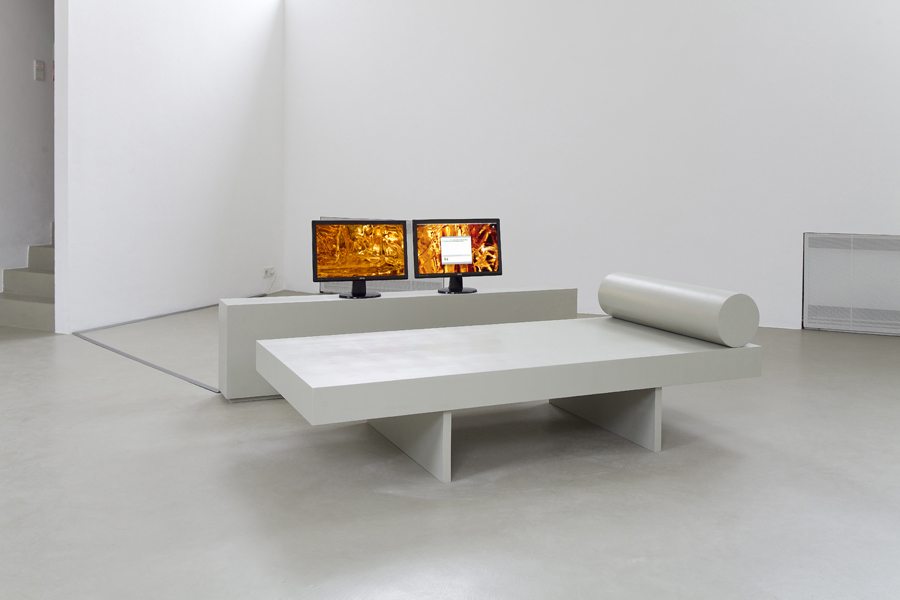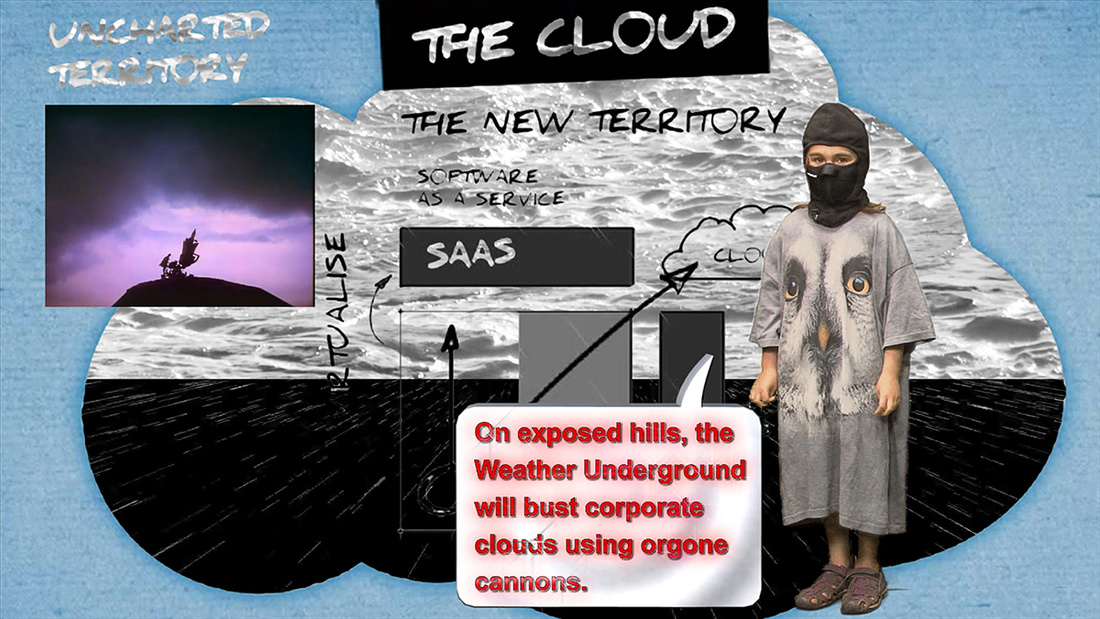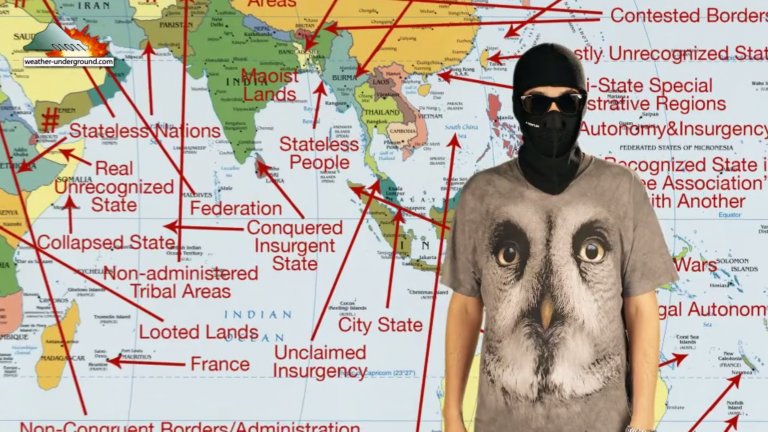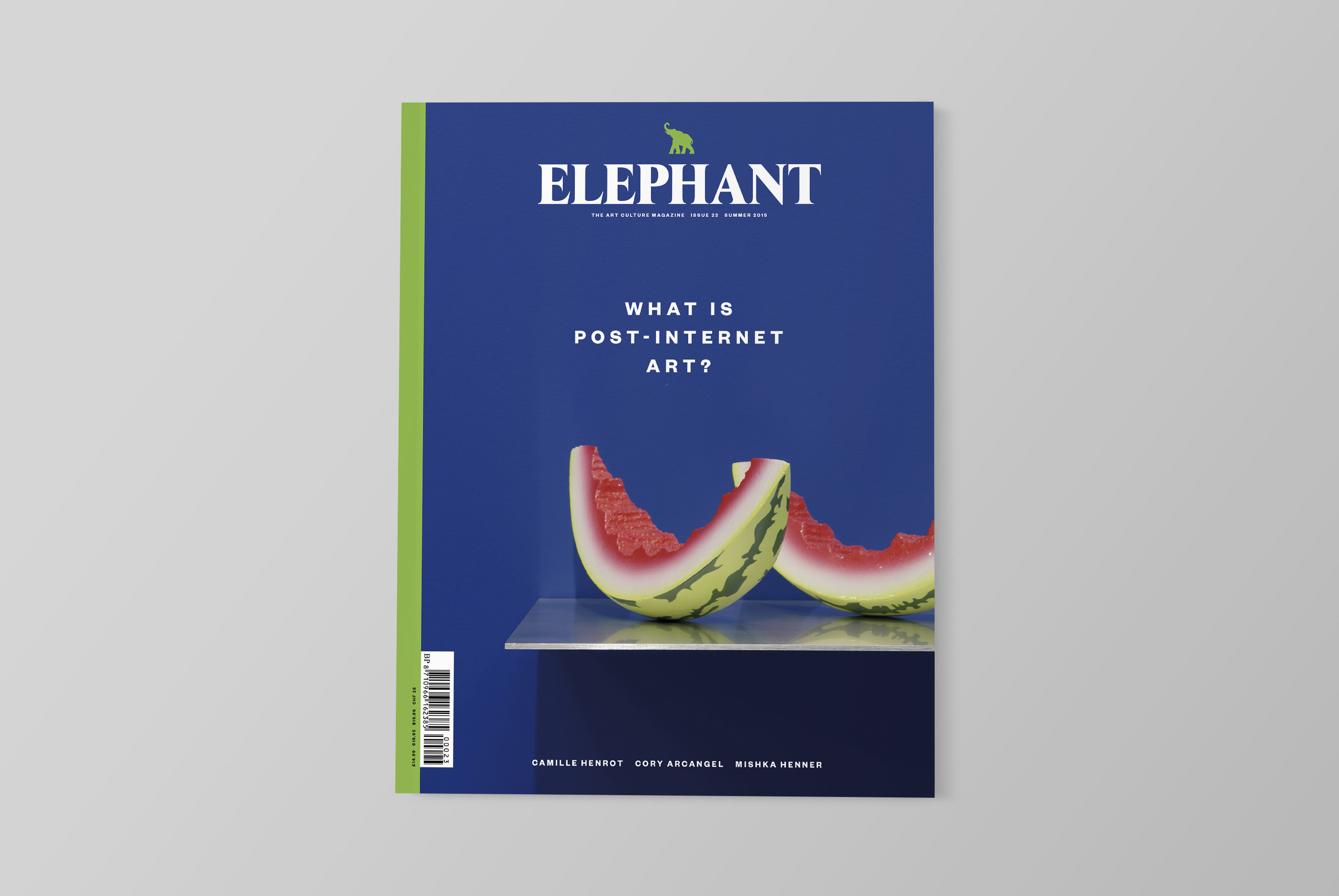
This feature was originally published in Issue 23.
It was the year that Post-Internet Art ‘finally cracked the market’. In 2014, a conversation that had been bubbling away for years between a small circle of international artists and critics became the latest trending aesthetic to flood into the mainstream. What ‘Post-Internet’ actually means is anyone’s guess (and everyone’s tried), but from the Zabludowicz in London to the Ullens in Beijing, it was here, there and everywhere. To paraphrase Hito Steyerl: the Post-Internet walked off-screen and straight into the white cube.
For art students and digital natives everywhere, this slow awakening seemed to signal the happy realization that they had been validated in our very own art-historical ‘post-’. Whether riding down uncanny valley on a Photoshop gradient or drinking the Kool Aid on a plastic beach, they had been Post-Internet practitioners all along!
But then, as Tumblr feeds lagged under an avalanche of GIF performances and Snapchat poetry, a suspicion set in, a sneaking sense of art-historical fomo. Could the Post-Internet be dead? Were we partying with an already-canonical corpse? Ben Vickers seems to think so. When I approached the Curator of Digital at the Serpentine Gallery for an interview, he cordially responded that he’d said all he had to say on the subject, pointing me to his notes from the ICA’s ‘Post-Internet aesthetics’ debate in late 2013. Vickers’s was a key voice in shaping much of the critical conversation that defined this baggy and insufficient phrase. At the ICA talk, he was already referring to the Post-Internet in the past tense, as something that ‘could have been’—but blew it.

Vickers’s position seems indicative of where the Post-Internet is now: there are many Post-Internets. The critic Brian Droitcour writes scathingly of it as a ‘brand exercise’, the art world’s most bankable new hashtag. It deliciously links snazzy pop aesthetics with actor network theory; memes materialize in white cubes, perfumed with critical vitality. Which is not to say that the work can’t be interesting, invigorating or beautiful: Artie Vierkant’s digitally transmuted Image Objects; Katja Novitskova’s Photoshop cut-out series, Approximations; or Ed Fornieles sprawling multimedia installations, to name a few. It’s often seductively modish, a little bit frightening and sincere about being tongue-in-cheek (after all, 2014 was also the year of PC Music).
Like most trends, it marks not a movement but a clique: the web-oriented video artist Erica Scourti tells me she doesn’t really see herself as part of the Post-Internet ‘thing’, that she sees it more ‘as describing a sociality, a group of people who I have some overlaps with but am not necessarily a part of’. To some, it’s feels like a revelation of networked realities, dispelling our misplaced faith in the material; to others, it’s descriptive of a routine contemporary banality, tedious and tautological in its obviousness. The term’s many modulations relieve it of almost all meaning and yet, as Droitcour writes, you’ll know it when you see it.
The Pre-Post-Internet; or, The Internet
The art historian Claire Bishop sparked a row in the pages of Artforum a few years ago when she complained that contemporary art had failed to ‘confront the question of what it means to see, feel and filter affect through the digital’. Despite some outcry from net-savvy curators, Bishop’s comments were percipient insofar as she was addressing the ‘mainstream’ art world, that great global machinery of curatorial politics, market logic and institutional validation that guides the ebb and flow of contemporary art discourse. Note the absence of artists in this mechanism, generations of whom have been interrogating the changing nature of our digital immersion for years. Early pioneers of web-based work like the Vuk Ćosić and the net.art movement, Eva and Franco Mattes, jodi.org, Young-Hae Chang Heavy Industries, along with magazines like Mute (now online only), organizations like Rhizome and curatorial projects like VVORK.org had long been engaged with the internet as art’s platform, medium and message, asking all the right questions since the mid-1990s.
Problem was, though, who noticed? Contemporary art operates on the rarefied discourse of the in-joke and the auratic economy of scarcity. Web-based works rarely took physical form, so these artists were seldom seen in galleries and collections as they were, by their very nature, easy to access and hard to sell. Moreover, the commercial art world takes few risks: it readily rejects languages in which it is illiterate and technologies that it does not understand (a kind of inversion of its relationship with continental philosophy, whose neologisms invariably seem to find their way into press releases without anyone stopping to understand them at all). For its part, much of the so-called ‘new media’ art that took off in the 1990s got so wowed by the size of its own algorithms that it forgot to be interesting. As Domenico Quaranta noted in his survey of the field: ‘In the contemporary art world, art is not appreciated as creative research on a given medium, but as a powerful statement on the world we are living in.’ Internet art bubbled away for years, but it belonged to the nerds: the Surf Clubs, the hacktivists and (more recently) the maker movement, who knew how to code but were rarely invited to the private view. Meanwhile, the art world was busy Instagramming white cubes full of whirring 16mm projections, getting a grainy high on analogue authenticity while they still could.
Post-What?
In his influential essay ‘The IRL Fetish’, Nathan Jurgensen coined the term ‘digital dualism’: the fallacy of an airtight divide between virtual and real, online and off, when in fact we live somewhere in between. Irrespective of the art world, the Post-Internet went mainstream because digital dualism became an unsustainable mass fantasy. That we exist through technological means shouldn’t be news to anybody, but nor is our resistance surprising. Socrates, the great Luddite, objected that the technology of writing would ruin the authenticity of memory—plus ça change.
But, clearly, something did change. At some point, memespace collided into meatspace and ‘the virtual’ fell out of half-read introductions to Guy Debord and into visceral, affective experience, leaving us to paddle about in the mulch. When Middle Eastern capitals look like SketchUp models and Pakistanis are picked off at random by American teens playing Call of Duty, ‘physical reality’ becomes a contested category. As usual, Hito Steyerl had it down, and poignantly: ‘an upload comes down as a shitstorm.’ Steyerl’s music-video-cum-essay-film How Not to Be Seen: A Fucking Didactic Educational .MOV File is a key text of the times, asking cryptically: ‘How do people disappear in an age of total over-visibility?’
The critic Steven Shaviro coined the term ‘post-cinematic affect’ in his study of pop-cultural phenomena that ‘give voice… to a kind of free-floating, ambient sensibility that permeates our society today’. The recent growth of CGI technologies into the ‘prosumer’ market has allowed artists like Ed Atkins, Cécile B. Evans and Jordan Wolfson to take the hyperreal surface of modern capitalism into their own hands or, rather, into the flawlessly smooth hands of the computer-generated avatar. It’s resulted in an explosion of the digital uncanny in the gallery space, pervaded by a certain schizoid sensibility of trying to find one’s feet on ever-shifting foundations. The artist Kate Cooper, who runs London collective Auto Italia South East, stated that today images ‘perform another function, and I’m interested in exploring the possibilities of what that agency could be, what that could produce. It’s very exciting.’ (The interview in question was with DIS Magazine, a laboratory of the Post-Internet par excellence, functioning as a discursive platform and a fashion magazine, while also operating a stock photo agency and selling art and fashion objects on the side.) This is a broader view of the ‘Post-Internet’, a thriving discourse around not only how the meaning of art and images has changed, but also how we feel about them. LaTurbo Avedon, an artist who exists solely in the form of a digital render, asserts that she’s ‘not hiding at all, just enjoying a straight connection with how I make and how I communicate in digital space’.

To anyone who is in the business of thinking about images, no single object is nearly so interesting as the way in which all images today are capriciously multiplied and transmitted, adopted and adapted. On the internet, the primacy of circulation of the network—of the node over the point—is not only obvious, it is insisted upon, blaring and unavoidable. Consequently, it’s also the primary way we look at and talk about art. This time last year, Jerry Saltz was complaining that collectors on Instagram were making all abstraction look the same. Installation shots look great on the white expanse of the webpage. Given the immaterial concerns of the Post-Internet discourse, one can imagine that the gallery setting becomes only one site among many in which the artwork can exist simultaneously, given the proliferation of online exhibitions and websites platforms like Vdrome.org. No time, no money, no attention? In times of austerity, the internet is post-scarcity.
Spam v. Trash
The Post-Internet places itself within and against contemporary art history, as its perennial motifs—private and public, identity and representation, mass culture and the readymade—find themselves extended and disturbed through the black mirror. The films of Ryan Trecartin (and frequent collaborator, Lizzie Fitch) have made him the enfant terrible of the Post-Internet condition, though he, too, does not fit neatly within its cultural niche. Trecartin’s films owe something to the line of queer, transgressive American cinema that runs through from John Waters, Paul McCarthy and George Kuchar. Like those antecedents, Trecartin’s films resemble delirious and grotesque send-ups of American culture that are both satirical and celebratory, featuring revellers lost in the psychosexual carnival of his Miami home. Rather than the America of Disneyland and exploitation flicks, Trecartin’s is the America of LEAVE BRITNEY ALONE!, the Kardashians and amateur porn. I’ve often wondered what the critics who’ve overseen Trecartin’s meteoric rise see in his work. Not that it isn’t brilliant, but, for me, the experience to which his films speak seems so specific to a generation, the headrush of YouTube tweens fuelled on Modafinil and techno-capitalism, spinning ever faster without any sign of slacking. Rather, it is relativity that gets lost, and a vertiginous sensation takes hold. Trecartin said in an interview: ‘I like exploiting certain things that I know are going to become dated. Pace is one of these. Every year we acclimate to a faster pace. Also pitch. In pop music the pitch keeps rising. Voices are moving out of human range.’

The frenetically edited dialogue in films like P.opular S.ky (section ish) (2009) and CENTER JENNY (2013) begin to wash over you incomprehensibly in a hyper-accelerated barrage of spam intensities, like the restless dreams of a sexually frustrated teenager passed out on the keyboard, while the playlist of a late-night YouTube binge plays on. Somewhere in the fray, there’s soul-searching for the transhuman, networked self—layered personas stuck together with adolescent angst and corporate buzzwords: ‘Don’t feel examplized,’ says one screen-within-a-screen. Watching all 40 minutes feels like an acid attack of undiluted digital affect. Steyerl has speculated that if an alien archaeologist were to excavate our legacy and take a forensic sample of our times, it would resemble ‘the spam of the earth’—equally, it might look like one of Trecartin’s films.
Post-Possibility
If the internet established radically new forms of social life, the Post-Internet should also present a roadmap of pertinent new models for art itself—its production, discussion, dissemination and reception. So much so far feels like a faceful of virtual candyfloss—art that spent a few hours on 4chan, or passed itself through a 3D printer, paying lip service to the digital gloss that coats contemporary life. As the artist Constant Dullaart put it in 2012: ‘Don’t use the internet as a fucking condiment!’ In this sense, the ‘Post-Internet’ is a firmly reactionary label, a making-strange of the already-been. Its air of transgressive urgency is fading fast—as if the internet were still surprising.
As a critical term, though, what the Post-Internet does seem to mark is a watershed. Life went viral because it had to. Art caught up with life and Bishop’s plea was answered—the last decade saw the maturation of a generation of artists for whom identity itself is self-evidently filtered through ‘digital affect’. In Erica Scourti’s Life in Adwords, the artist recites to webcam monthly diary entries as keywords, transliterated by Google’s advertising algorithm: ‘Video funny. Anxious children. Psychology job. Fear of rejection.’ The project lasted almost a year, before Gmail’s settings changed. Scourti’s commodified confessionals also foreground the fact that that the web is far from free—rather, it is substantially opaque, its ostensibly public channels operated on by privatized logic. The twentieth century took it upon itself to break down our relationship with language and to violently deconstruct the image. Even as our web literacy increases, our capacity to understand its increasing ubiquity remains at the level of the ‘user’, the consumer of a seemingly hermetic abstraction. Art might like to talk about what it feels like to live through social media, but by and large artists find themselves complicit like everyone else; they are always 12 steps behind the tech companies; the parameters of their freedom are established elsewhere.
Although what the New York-based artist Tyler Coburn tells me he is not involved with the ‘social community’ of the Post-Internet, his wide-ranging practice is preoccupied with relations of power and labour engendered through technological mediation in the internet era. His work I’m That Angel is a closet drama that at one point sees its protagonist—a content farmer—move back in with Mum and Dad (Facebook and Wikipedia) before renting out his headspace as a data server. Another project, NaturallySpeaking, was an experimental essay about the history of voice recognition performed by Susan Bennett, the actress who voiced Apple’s original Siri. He’s currently making a film about ‘smart urbanization’—the application of big data gathered through monitoring and surveillance in city-building—based on interviews with data monitors, which seeks to ‘parse the difference between the machinic sensor and human sense’. Coburn figures as one of a category of artists (among the likes of Zach Blas, Trevor Paglen, Hito Steyerl, James Bridle and so on) whose critically minded practices interrogate the political and philosophical underpinnings of our seamless digital fantasies.

In a conversation over Skype about where the Post-Internet might lead, Coburn suggests: ‘We do need media literacy—a lot of post-internet art reflexively performs to prosumerist and circulationist measure, failing to consider that the internet is a depth model, as well as a frictionless surface.’ Much of Coburn’s work reflects a desire to understand the present against a broader scope, to consider the technological and epochal shifts that are taking place beyond the market’s voracious appetite for novelty. ‘The moment of geopolitics, the moment of capitalism that we’re living, is not comparable to earlier periods: nor is the “self”, in its connotations and preoccupations, continuous across time. Nonetheless, there are reverberations across eras. If I’m contributing to the discourse, it’s in trying to make them audible.’
Where do we go from here, and how might new practices bridge this conceptual shortfall? ‘In the near future we’ll reach a point when the internet is no less ubiquitous, but the market has moved on,’ says Coburn. ‘The market will endorse new stylistic templates, potentially freeing “Post-Internet” from its now primarily commercial associations. In other words, we may see the emergence of other types of practices that can be meaningfully contextualized as Post-Internet. The hope is that, in the shift from simply performing prosumerism to something else, more attempts are made to become literate in the network’s underlying languages.’
The Post-Internet is a condition of sorts: an affective affliction of when the ego got lost in the cloud. Coburn’s position aligns him with someone like Ben Vickers, whose remarks two long years ago—enough for a generation to pass in internet time—feel just as relevant today. The thing is, there is no alternative: we’re all Post-Internet artists now. But it’s also a condition in the sense of a prerequisite, an injunction for contemporary artists to reflect upon the world in which they live, one in which metaphysical experience and social reality are guided by the vectors and velocities of technological change.
One imagines that the artists who emerge in this landscape might be interdisciplinary practitioners, found at the intersection of painters, poets, designers and hackers, capable of crafting new meanings in the new context. The days of ‘Post-Internet’ are numbered, but the transformative role of the digital in managing and mediating our lives will doubtlessly charge headlong into unknown territories. Rather than dwelling on the Post-Internet, it might be time to move on—to think in terms of pre- something else.





